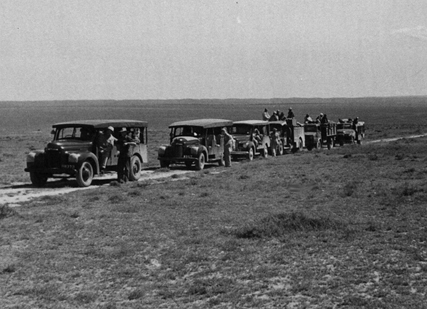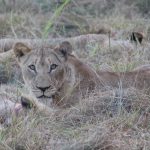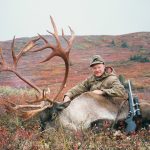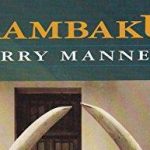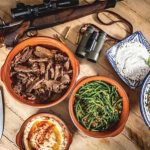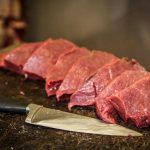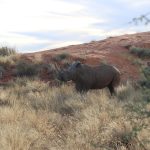Over the course of sixty years, safaris have undergone a radical transformation.
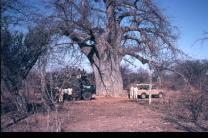
Story and photos by Harry SelbyOver many years, the word “safari”–that magical word which brings to mind high adventure in the wilds of Africa, immortalized by Theodore Roosevelt, Martin and Osa Johnson, Ernest Hemingway, and Robert Ruark–has become synonymous with a hunting/photographic expedition involving sportsmen and women from across the world.
A safari in the earliest days of East Africa, prior to the outbreak of World War I, was known as a “foot safari.” It would consist of a group of a hundred or more people, including a number of visiting hunters, one or more professional hunters, local gunbearers, cooks, and skinners, but the majority would be porters who carried loads made up of tents, camping equipment, and food for the entire group. Everyone walked, as horses and donkeys would not survive due to the dreaded disease-carrying tsetse fly infesting most of the hunting areas.
The origin of the safaris I will discuss in this article, however, coincided with the use of motor vehicles on safari sometime in the 1920s. These safaris typically numbered from twelve to twenty people, and they were completely self-sufficient, willing and able to cope with whatever situation might crop up. The professional hunter and his clients rode in a hunting car and a baggage truck followed, carrying everything required to set up camp wherever one chose–staff, fuel, foodstuffs, tentage, medical chest, camping furniture, cooking utensils, and china tableware; later, even refrigerators were provided.
Safari vehicles on the move in Masailand in the 1940s.
The professional hunter was truly the “captain of the ship” and the success of the entire safari, its well-being, and even the lives of the group depended on his decisions. A competent professional hunter was of necessity knowledgeable and a pleasant companion, at times a diplomat, a doctor, and a mechanic; hunting was second nature to him. Furthermore, he required a sound knowledge of the country and the local people, leadership qualities, self-reliance, and the ability to handle a difficult situation, especially when the clients were often men controlling huge business empires and who were used to giving the orders, not taking them.
When a safari left Nairobi for perhaps one or two months in the field, there was no easy way to contact the Nairobi office even in an emergency. If an accident should occur, or a member of the party became ill, recovery would follow in time. If the situation was very serious, one of the small single-engine aircraft stationed in Nairobi would need to be summoned, and even that in itself was no simple matter as in the remote centers where there might be a phone, which sometimes worked, long delays of many hours could be expected. In many cases, a makeshift landing strip would have to be cleared, and then dragged with a large bush attached to the hunting vehicle in order to smooth it sufficiently for an aircraft to land.
For urgent incoming messages, safaris relied on an arrangement with the local Nairobi broadcasting station that after the nine o’clock evening news an urgent message could be transmitted to a safari in the field. An announcement prior to the news broadcast advised that there would be a message for a certain group or individual, resulting in a very tense twenty minutes of news while the group waited for the message, which usually was not good, and then the frustration of being unable to reply to it.
During the late 1950s and early 1960s, two-way HF radios became available and made a tremendous difference to the isolated safari in the field; in fact, their arrival on the scene could be considered one of the two fundamental landmarks in the history of safari, together with the advent of the four-wheel-drive vehicle.
Mobile Safari
As all traveling was by vehicle, it could take three days of hard driving to reach the intended hunting grounds in southern Tanganyika (now Tanzania), Western Uganda, or the Southern Sudan from Nairobi, but it would be interesting, seeing colorful people from various tribes such as the Masai, Samburu, and the Dinka; extinct volcanoes; snow-capped mountains; beautiful lakes; forests of huge baobabs; and historical sites such as the compound shared by Livingstone and Stanley near Tabora. If the route should cross the Serengeti after skirting the rim of wildlife-rich Ngorongoro Crater, one would see, if the annual migration was in full swing, unbelievable numbers of wildebeest, zebra, antelopes of various species, and gazelles on the move, followed by prides of lions and other predators.
On long trips, the hunting party would bivouac beside the road in order to get going again early the next morning, and, amazingly, a very acceptable meal would be forthcoming from the cook within a couple of hours of having halted for the night. There would be a breakfast of bacon, eggs, toast, and coffee the following morning, before the safari got under way again.
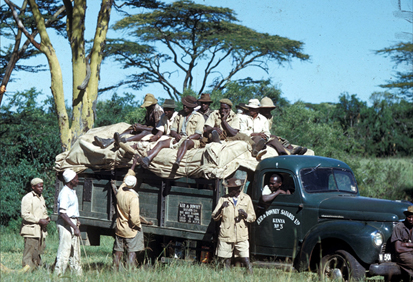
The safari staff usually rode atop the loaded baggage truck.
Eventually, on reaching the hunting area, the camp would be erected by experienced hands and made habitable in a matter of hours. In this way, it was possible to move very freely and rapidly from area to area, especially as there were no concessions in existence, or blocks to be booked, and quotas were unheard of. Hunting was lawful anywhere so long as the area was not a game reserve, national park, or private land. If the safari moved into an area and found it was disappointing, it pulled up stakes and moved on.
The number of animals allowed on each hunter’s license was overly generous, having been formulated at a time when the early foot safari would require meat for eighty to 100 people over several months. For example: twelve buffalo, twenty zebra, twenty wildebeest, twenty kongoni, four lions, unlimited leopards, and equally generous numbers of all other species. Elephant and rhino required a special license even then, as the elephant ivory and rhino horn could be sold.
The complacent colonial government controlled from London took a long time to initiate a reappraisal of the entire licensing system, and that didn’t happen until some years after World War II. It often required tact and a firm hand on the part of the professional hunter to prevent abuse by trigger-happy individuals.
In those early days, the time factor was not as important as it is today. Safaris often lasted for two months or possibly three. I would estimate that a third of the entire safari would be spent traveling from one hunting area to another, and many hours would be spent getting the heavily laden vehicles freed from the clutches of either tenacious mud or heavy sand.
Remember, too, that safaris did not have four-wheel-drive vehicles, so a lot of hunting was done on foot, which took time and was hard work. It was generally agreed that 100 miles, plus or minus, would be walked for every elephant taken with tusks of 90 pounds or more. I remember spending a whole week at Kondoa Irangi in Tanganyika clambering up and down steep, rocky hills until a kudu was finally bagged.
In those days, more emphasis was placed on the entire safari experience–photography and bird shooting, for instance–rather than just the collecting of trophies. Naturally, clients expected to get good trophies. It was the collecting of them that provided the thrill, and a fine trophy was the reward for a memorable hunt. Today, the burning question as soon as a trophy is bagged often is: “Will it qualify for the record book?”—sadly, sometimes, irrespective of how it was hunted.
As hunting pressure increased in the most accessible areas, some pioneering and resourceful professional hunters cut tracks or built makeshift bridges to get into virgin country and escape the ever-increasing number of safaris entering the field. There were occasions when an entire day might be spent manhandling the two-wheel-drive safari vehicles over a soft sand riverbed. Several days might be spent erecting a makeshift bridge.
If a previously used river crossing had become too deep to ford with a hunting vehicle, and you needed to hunt the opposite side, you simply removed everything from the vehicle, including tools and spares, disconnected the battery, drained all oil and fuel, and then, using the heavy rope every safari carried, your crew, possibly assisted by locals, pulled the vehicle through the river, sometimes completely submerged.
After a night to dry out with the drain plugs removed, the oil and fuel were refilled, the battery reconnected, and the hunt continued. The hunters would cross the river morning and evening between camp and hunting car by dugout canoe or wading; the hunting car stayed on the other side of the river until the safari was ready to leave that area, at which time it was pulled it back through the river again.
Miracle Workers
The professional hunter was, at times, called upon to perform near-miracles mechanically and medically, as a few incidents that took place on my safaris will illustrate. I remember one cold, windy night on the Serengeti at one o’clock in the morning, soldering the leaking radiator of the baggage truck carrying the camp equipment. I heated the soldering iron in a fire made of wildebeest dung, as there was no wood. Our supper had been prepared the same way.
One evening at Ikoma, after traveling for three days from Nairobi, one of the skinners was bitten by a snake as he opened up his bedroll. He became hysterical, so I had him rushed to the mess tent, where the only bright light on the safari was kept, to examine the bite. I found two fang punctures, indicating a bite from a venomous snake. I proceeded to administer the antivenin shots to the protesting man, oblivious to the fact that four wide-eyed clients were watching the whole performance. Next morning he was sore, but OK; either the antivenin had done its job or he had received a “dry” bite, as I understand sometimes happens.
On one safari, we were camped south of Ngorongoro in the vicinity of Lake Eyasi in Tanganyika. Our camp was situated a couple of hundred yards from a steep-sided donga (ditch), at the bottom of which flowed a small stream. When we drove into camp about midday after one morning’s hunt, Juma, my headman, informed me that the truck was in trouble at the river.
It transpired that the truck had been driven there with two of the staff in order to fill the water drums on the back. The driver walked back to camp. When the drums were filled, the men called to the driver to retrieve the truck. He was a bit slow, and a young lad, the cook’s helper, climbed into the cab and while fiddling with the controls, pressed the starter button.
The truck was parked in reverse gear, and unfortunately the engine fired instantly and the truck rolled backward over the bank into the stream, winding up with all wheels in the air. That was what met my horrified gaze when I walked to the spot. We were miles from nowhere, and there was no radio in camp in those days.
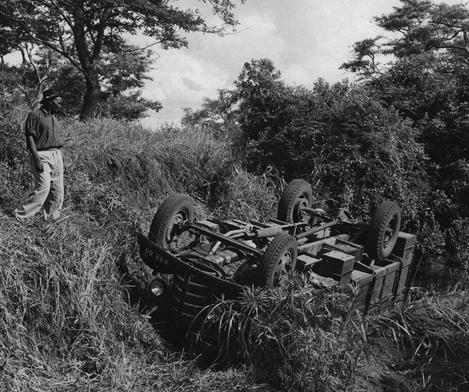
The safari truck overturned in the riverbed, miles from nowhere.
We had to fend for ourselves, so for the next day or two while we were hunting, the camp staff busied themselves digging one bank down sufficiently to allow the truck to be hauled up.
When this was completed, we attached the big rope to the far side of the truck and to the rear of my hunting car on the opposite bank. When all was ready the hunting car, assisted by our crew and a number of friendly locals to whom we had given meat, hauled on the rope and, fortunately, we were able to turn the truck back on its wheels, and finally pull it up the bank.
I will never forget one unfortunate safari: Shortly after we had crossed into Tanganyika from Kenya, the baggage truck did not arrive when I stopped for it to catch up. I had a foreboding that all was not well, and a couple of miles back I found it lying on its side, having rolled over after having gone into a skid aggravated by the shifting weight of the men perched on top of the load.
As I drove up, Juma came forward, and in reply to my question, “Is anyone dead?” he replied, “Only one.”
Two other men were badly injured, and after getting the truck back on its wheels I instructed Juma to pitch a tent beside the road for the clients. I then took the two injured men and the corpse back into Kenya in the hunting car. The injured men I left at the reasonably sophisticated hospital in Narok, in Masailand, as traveling was very painful for them. I phoned Nairobi telling them what had happened and asked that replacements be on hand. I then carried on to Nairobi with the body of the unfortunate skinner.
When I returned to the safari, we hastily packed up and carried on across the Serengeti to Banagi, where we bivouacked. I had been without sleep for sixty hours.
Changing Times
During the 1950s, hunting areas in Kenya came under increasing pressure as more clients decided to hunt in Africa and more “occasional” hunters took up professional hunting, some with limited experience. The Game Department tried to lessen the pressure on the game populations, especially the Big Five, by allowing the taking of only one of the Big Five per week of safari. Should a hunter want licenses to hunt all five, the safari must last at least five weeks. This measure helped to some extent, as with the advent of the four-wheel-drive vehicle, hunting became easier as remote areas became more accessible and some clients tried to collect huge bags in the shortest possible time.
During the late 1950s, the “block” system was introduced in Kenya: the country was divided into numbered blocks. It was necessary to reserve the chosen block sometimes months in advance, with no idea of what would be found there when the safari finally arrived. If the game situation was really disappointing, the safari had to wait until its next block booking became available before moving on.
Other changes were making themselves felt as well. East Africa was in a state of political flux; Kenya had experienced six or seven years of the Mau Mau insurrection, and independence from Britain was the goal of all three East African territories–Kenya, Tanganyika, and Uganda, and independence was being actively negotiated by their representatives with the British government. No one had any idea what a post-independence East Africa would be like, especially after the Congo debacle.
In the early 1960s, I moved with my family to Bechuanaland (now Botswana) and opened a branch of Ker, Downey & Selby Safaris there. Our company was granted two very large tracts of land known as “concessions” in which to conduct hunting safaris. One was adjacent to the Okavango Delta, and the other was in the northern Kalahari.
The distances between camps in these concessions was not great, and I soon realized that a more efficient method of operation would be to have static camps, fully staffed, at strategic locations. The clients, together with the hunter and hunting vehicle, would move from one camp to another, thus reducing overhead by literally halving the staff that had been required to pitch and break camps during the days of the mobile safari.
One supply vehicle would do the supply rounds periodically, thus eliminating the situation where a truck remained idle for long periods in each camp. This arrangement worked very well, and in fact it had been in operation in Mozambique and Angola for some time, before politically motivated insurgencies erupted there.
Due to a number of factors, the traditional mobile safari was gradually on its way out in the East African countries where it had originated. Border controls on individuals, vehicles, equipment, and firearms, and the transfer of funds between newly independent states became a problem. Safaris did continue to flourish in Kenya for some years after independence in 1963, often ranging as far north as the Sudan, until, unexpectedly, the Kenya government closed all hunting in 1977. Safaris already in the field were summoned back to Nairobi, and hunting has remained closed there ever since, effectively putting an end to the “classic East African safari.”

Harry Selby with his safari crew and several clients in Kenya in 1950.
After independence in 1961, Tanzania, previously Tanganyika, created a state-owned and controlled safari organization which prohibited private safari companies from conducting safaris. The venture was not a success.
For some years, Botswana was one of the very few countries in Africa where no independence struggle was taking place. Rhodesia, Angola, Mozambique, and South-West Africa were all coping with bush wars. Eventually, as the political and security situation improved in those countries, and South Africa joined the ranks of countries offering hunting safaris, the “static camp” became the only way to go
When privately owned safari companies were allowed to resume operations in Tanzania after the disastrous attempt to establish a state-controlled organization, a similar system of static camps was employed there, except that a hunting car remained in each camp and aircraft were used to transfer clients and their hunter from one camp to another.
To establish a static camp, it was necessary to have an exclusive lease on the area, so concessions or some form of lease on specific blocks became the norm in most countries where the land was government-owned. In some countries, large privately owned ranches became “game farms” where the emphasis was on breeding game animals rather than domestic stock. Static hunting camps were established on these ranches to accommodate visiting hunters.
Initially, these static camps consisted of the standard safari tents with a flush toilet and shower enclosure attached to the rear. Semi-permanent structures were provided for the mess and the kitchen, which was equipped with the necessary furniture and a gas stove.
As time progressed, the camps in some countries became more sophisticated being erected on wooden decks, with regular furniture and in many cases electric power for lighting, ice making, and refrigeration. VHF radio contact with base became standard in all camps and in many of them a satellite phone is provided. Today, some clients bring their own satellite phones, and many camps are within easy reach of airfields and helicopters are available on call should an emergency occur.
Moving clients over short distances is usually accomplished by vehicle, but where long distances are involved, aircraft are used. This cuts traveling time considerably, resulting in significant savings to the client and allows for more time to be spent hunting, making it possible for hunters who previously had been unable to spare both the time and the money to undertake an African safari to do so. Now most safaris are between ten and twenty days long.
Air travel today is so available and quick that within a couple of days of leaving home, the clients are in the hunting camp, and as they have possibly read all about safaris or been to one or more conventions, they arrive with their wish list in one hand and, possibly, the record book in the other, ready to begin hunting.
The hunting will be intensive because of the short time available, and any mishap such as the hunting vehicle getting badly bogged down or malfunctioning might be regarded by the clients as time wasted. In some cases they might even expect a refund.
The professional hunter will be under considerable pressure to “produce”—and, greatly to the credit of the present-day PHs, successful hunts and very fine trophies are being brought in.
The clients, unless camped in tribal areas, will see very little of Africa or its people, other than a few hanging around the airport where they landed before leaving by vehicle or aircraft on the way to the camp.
I realize that the only way game will survive in Africa is to pay very handsomely for its existence, and the only way that can be achieved is by bringing in more hunters, photographers, and general tourists, all attracted by Africa’s magnificent wildlife, all bringing money into the country, thus demonstrating to the local people that the wildlife is more valuable on the hoof than in their bellies. To achieve that situation, permanent camps and air transport are essential to make it affordable, both in time and cost.
It was inevitable that “safari” had to change, and it will continue to change in order to exist. Africa itself has changed out of all recognition both physically and politically, and the old-time self-contained safari would have no place to go in today’s Africa. There are hunters today who would prefer to have experienced the sense of freedom of an old-time safari, as I am sure there were those who went on safari many years ago who would have preferred something along the lines of what is offered today. The two experiences are as different as night is from day; the only feature common to both is the name. . . that magical word, “safari.”

